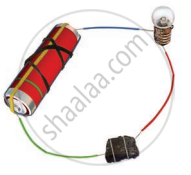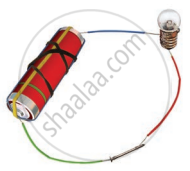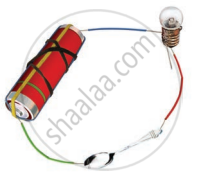Advertisements
Online Mock Tests
Chapters
2: Microorganisms : Friend and Foe
3: Synthetic Fibres and Plastics
4: Materials : Metals and Non-Metals
5: Coal and Petroleum
6: Combustion and Flame
7: Conservation of Plants and Animals
8: Cell—Structure and Functions
9: Reproduction in Animals
10: Reaching the Age of Adolescence
11: Force
12: Friction
13: Sound
▶ 14: Chemical Effects of Electric Current
15: Some Natural Phenomena
16: Light
17: Stars and Solar System
18: Pollution of Air and Water
![NCERT Exemplar solutions for Science [English] Class 8 chapter 14 - Chemical Effects of Electric Current NCERT Exemplar solutions for Science [English] Class 8 chapter 14 - Chemical Effects of Electric Current - Shaalaa.com](/images/science-english-class-8_6:5f2b1b2038084cf381bfa42c826a928c.jpg)
Advertisements
Solutions for Chapter 14: Chemical Effects of Electric Current
Below listed, you can find solutions for Chapter 14 of CBSE NCERT Exemplar for Science [English] Class 8.
NCERT Exemplar solutions for Science [English] Class 8 14 Chemical Effects of Electric Current Multiple Choice Questions [Pages 77 - 78]
An electric current can produce
heating effect
chemical effect
magnetic effect
chemical, heating and magnetic effects
Boojho and Paheli performed experiments taking similar bulbs and cells but two different solutions A and B as shown in the figure.
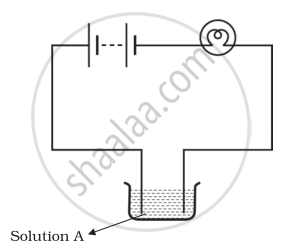 |
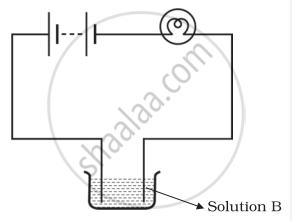 |
| Boojho's Experiment | Paheli's Experiment |
| (A) | (B) |
They found that the bulb in the set up A glows more brightly as compared to that of the set up B. You would conclude that
higher current is flowing through the circuit in set up A
higher current is flowing through the circuit in set up B
equal current is flowing through both the circuits
the current flowing through the circuits in the two set up cannot be compared in this manner.
Boojho’s uncle has set up an electroplating factory near his village. He should dispose off, the waste of the factory
in the nearby river
in the nearby pond
in the nearby cornfield
according to the disposal guidelines of the local authority
When electric current is passed through a conducting solution, there is a change of colour of the solution. This indicates
the chemical effect of current
the heating effect of current
the magnetic effect of current
the lightning effect of current
Which one of the following solutions will not conduct electricity?
Lemon juice
Vinegar
Tap water
Vegetable oil
Which of the following metals is used in electroplating to make objects appear shining?
Iron
Copper
Chromium
Aluminium

Which of the following solutions will not make the bulb glow in figure?
Sodium chloride
Copper sulphate
Silver nitrate
Sugar solution in diluted water
NCERT Exemplar solutions for Science [English] Class 8 14 Chemical Effects of Electric Current Very Short Answer Questions [Page 79]
Fill in the blanks.
The object to be electroplated is taken as ______ electrode.
One of the most common applications of chemical effect of electric current is ______.
Small amount of a mineral salt present naturally in water makes it a ______ of electricity.
Electroplating of ______ is done on objects like water taps and cycle bell to give them a shiny appearance.
Why is a layer of zinc coated over iron?
Will the solution of sugar in distilled water conduct electricity?
Name the effect of current responsible for the glow of the bulb in an electric circuit.
NCERT Exemplar solutions for Science [English] Class 8 14 Chemical Effects of Electric Current Short Answer Questions [Pages 79 - 81]
Boojho made the circuit given in the figure and observed that the bulb did not glow. On Paheli’s suggestion, he added one more cell in the circuit. The bulb now glows. Explain.
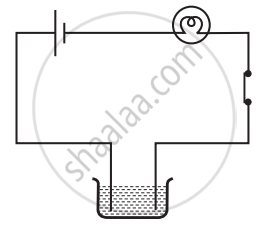
Paheli set up an experiment using liquid A in the beaker as shown in the figure. She observed that the bulb glows. Then, she replaced the liquid A by another liquid B. This time the bulb did not glow. Boojho suggested replacing the bulb by an LED. They observed that the LED glows. Explain.
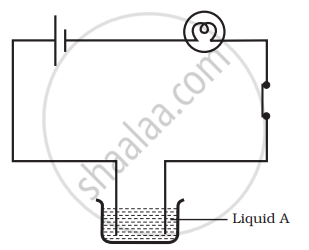
Paheli wants to deposit silver on an iron spoon. She took silver nitrate (AgNO3) solution in a beaker and set up a simple circuit for electroplating. Which terminal of the battery should the spoon be connected to? What material should the other electrode be made of?
Why is tin electroplated on iron to make cans used for storing food?
Observe figure.
 |
 |
| A | B |
Which of these two circuits A or B shows the correct observation?
Observe the following circuits carefully. In which circuit will the bulb glow? Write Yes or No in the blank space provided along each of the circuit given in the figure.
|
(a) |
Piece of coal |
______ |
|
(b) |
Iron nail |
______ |
|
(c) |
Eraser |
______ |
|
(d) |
Steel spoon |
______ |
NCERT Exemplar solutions for Science [English] Class 8 14 Chemical Effects of Electric Current Long Answer Questions [Pages 82 - 85]
An electric current is passed through a conducting solution. List any three possible observations.
In the circuit given in the figure,
Boojho observed that copper is deposited on the electrode connected to the negative terminal of the battery.
Paheli tried to repeat the same experiment. But she could find only one copper plate. Therefore, she took a carbon rod as negative electrode. Will copper be still deposited on the carbon rod? Explain your answer.
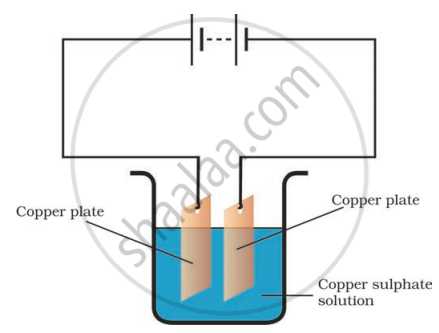
Observe the circuit given in the figure.
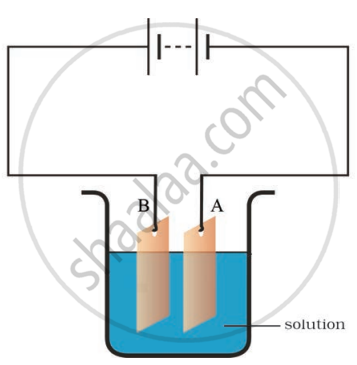
Boojho set up this circuit for purification of copper. What will be the nature of – (a) plate A (b) plate B (c) and the solution.
Explain the process of purification.
Observe the following circuit given in the figure.
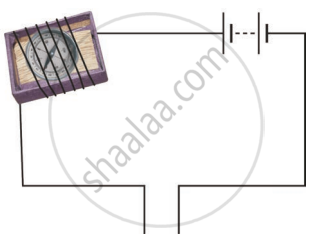
Current does not flow in the circuit, if there is a gap between the two wires. Does it indicate that air is a poor conductor of electricity? Does air never conduct electricity? Explain.
Boojho made the circuit as shown in the figure. He wanted to observe what happens when an electric current is passed through water. But he forgot to add a few drops of lemon juice to water. Will it make any difference to his observations? Explain.
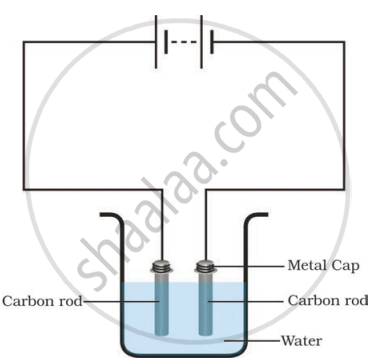
Observing that the bulb does not glow in the circuit shown in Fig. (A) Boojho changed the circuit as shown in Fig. (B). He observed deflection in the magnetic compass.
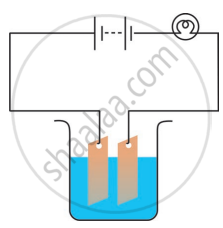 |
 |
| A | B |
- What does the deflection in magnetic compass indicate?
- Why did the bulb not glow in Fig. (A)?
- What would be the effect of increase in the number of turns in the coil wound around the magnetic compass in Fig. (B)?
- What will be observed if the number of cells are increased in the circuit shown in Fig. (B)?
You are provided with a magnetic compass, an empty matchbox, a battery of two cells and connecting wires. Using these objects, how will you make a tester for testing an electric circuit? Draw the necessary circuit diagram and explain.
Solutions for 14: Chemical Effects of Electric Current
![NCERT Exemplar solutions for Science [English] Class 8 chapter 14 - Chemical Effects of Electric Current NCERT Exemplar solutions for Science [English] Class 8 chapter 14 - Chemical Effects of Electric Current - Shaalaa.com](/images/science-english-class-8_6:5f2b1b2038084cf381bfa42c826a928c.jpg)
NCERT Exemplar solutions for Science [English] Class 8 chapter 14 - Chemical Effects of Electric Current
Shaalaa.com has the CBSE Mathematics Science [English] Class 8 CBSE solutions in a manner that help students grasp basic concepts better and faster. The detailed, step-by-step solutions will help you understand the concepts better and clarify any confusion. NCERT Exemplar solutions for Mathematics Science [English] Class 8 CBSE 14 (Chemical Effects of Electric Current) include all questions with answers and detailed explanations. This will clear students' doubts about questions and improve their application skills while preparing for board exams.
Further, we at Shaalaa.com provide such solutions so students can prepare for written exams. NCERT Exemplar textbook solutions can be a core help for self-study and provide excellent self-help guidance for students.
Concepts covered in Science [English] Class 8 chapter 14 Chemical Effects of Electric Current are Conductor of Electricity: Liquid, Chemical Effects of Electric Current, Electricity, Conductors and Insulators.
Using NCERT Exemplar Science [English] Class 8 solutions Chemical Effects of Electric Current exercise by students is an easy way to prepare for the exams, as they involve solutions arranged chapter-wise and also page-wise. The questions involved in NCERT Exemplar Solutions are essential questions that can be asked in the final exam. Maximum CBSE Science [English] Class 8 students prefer NCERT Exemplar Textbook Solutions to score more in exams.
Get the free view of Chapter 14, Chemical Effects of Electric Current Science [English] Class 8 additional questions for Mathematics Science [English] Class 8 CBSE, and you can use Shaalaa.com to keep it handy for your exam preparation.
